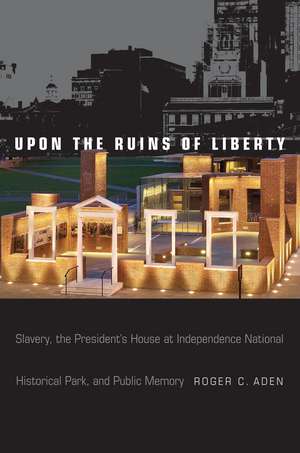Upon the Ruins of Liberty: Slavery, the President's House at Independence National Historical Park, and Public Memory
Autor Roger C. Adenen Limba Engleză Hardback – 18 dec 2014
The 2002 revelation that George Washington kept slaves in his executive mansion at Philadelphia's Independence National Historical Park in the 1790s prompted an eight-year controversy about the role of slavery in America's commemorative landscape. When the President's House installation opened in 2010, it became the first federal property to feature a slave memorial.
In Upon the Ruins of Liberty, Roger Aden offers a compelling account that explores the development of this important historic site and how history, space, and public memory intersected with contemporary racial politics. Aden constructs this engrossing tale by drawing on archival material and interviews with principal figures in the controversy-including historian Ed Lawler, site activist Michael Coard, and site designer Emanuel Kelly.
Upon the Ruins of Liberty chronicles the politically-charged efforts to create a fitting tribute to the place where George Washington (and later, John Adams) shaped the presidency while denying freedom to the nine enslaved Africans in his household. From design to execution, the plans prompted advocates to embrace stories informed by race, and address difficulties that included how to handle the results of the site excavation. As such, this landmark project raised concerns and provided lessons about the role of public memory and how places are made to shape the nation's identity.
In Upon the Ruins of Liberty, Roger Aden offers a compelling account that explores the development of this important historic site and how history, space, and public memory intersected with contemporary racial politics. Aden constructs this engrossing tale by drawing on archival material and interviews with principal figures in the controversy-including historian Ed Lawler, site activist Michael Coard, and site designer Emanuel Kelly.
Upon the Ruins of Liberty chronicles the politically-charged efforts to create a fitting tribute to the place where George Washington (and later, John Adams) shaped the presidency while denying freedom to the nine enslaved Africans in his household. From design to execution, the plans prompted advocates to embrace stories informed by race, and address difficulties that included how to handle the results of the site excavation. As such, this landmark project raised concerns and provided lessons about the role of public memory and how places are made to shape the nation's identity.
Preț: 490.14 lei
Preț vechi: 636.54 lei
-23% Nou
Puncte Express: 735
Preț estimativ în valută:
93.78€ • 97.93$ • 77.45£
93.78€ • 97.93$ • 77.45£
Carte indisponibilă temporar
Doresc să fiu notificat când acest titlu va fi disponibil:
Se trimite...
Preluare comenzi: 021 569.72.76
Specificații
ISBN-13: 9781439911990
ISBN-10: 1439911991
Pagini: 264
Dimensiuni: 152 x 229 x 25 mm
Greutate: 0.5 kg
Editura: Temple University Press
Colecția Temple University Press
ISBN-10: 1439911991
Pagini: 264
Dimensiuni: 152 x 229 x 25 mm
Greutate: 0.5 kg
Editura: Temple University Press
Colecția Temple University Press
Recenzii
Aden's is one of the best book-length case studies I have seen on contested sites like the president's house. --Ken Foote
Notă biografică
Roger C. Aden is Professor in the School of Communication Studies at Ohio University. He is the author of Popular Stories and Promised Lands: Fan Cultures and Symbolic Pilgrimages and Huskerville: A Story of Nebraska Football, Fans, and the Power of Place.
Cuprins
Preface
1 Discovering the Truth: The Revelation of Ugly History
2 Re-collecting the Past: The Complexity of Public Memory
3 Displacing the Inconvenient: The Incomplete Story of Liberty
4 Honoring the Ancestors: The Quest for Acknowledgment
5 Shaping the Place: The Design Competition
6 Revealing the Foundations: The Excavation of the Site
7 Telling the Stories: The Opening of the Installation
8 Continuing the Conversation: The Legacy of the President’s House
Acknowledgments
Notes
Index
1 Discovering the Truth: The Revelation of Ugly History
2 Re-collecting the Past: The Complexity of Public Memory
3 Displacing the Inconvenient: The Incomplete Story of Liberty
4 Honoring the Ancestors: The Quest for Acknowledgment
5 Shaping the Place: The Design Competition
6 Revealing the Foundations: The Excavation of the Site
7 Telling the Stories: The Opening of the Installation
8 Continuing the Conversation: The Legacy of the President’s House
Acknowledgments
Notes
Index
